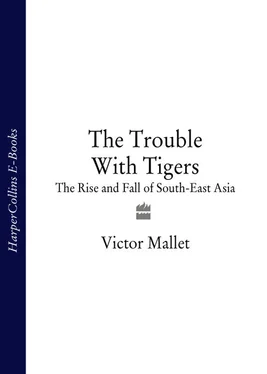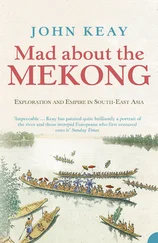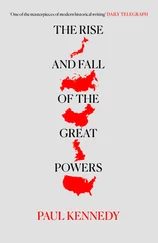The biggest test of Asean’s unity, however, is not Indonesia but Burma. It is one thing to use the concept of ‘Asian values’ to defend the rights of, say, Singapore and Malaysia to restrict personal freedoms in the interest of economic growth and political stability: such countries have been labelled ‘soft authoritarian’ by political scientists. But Burma is by no means soft. It is ruled by a military junta which has tortured and killed hundreds of its opponents, and which has condemned what should be one of Asia’s wealthiest countries – fertile, rich in minerals, attractive to tourists and home to fifty million people – to poverty and oppression. The junta was so out of touch with its own people that it was convinced it would win a democratic election it organized in 1990. When it was resoundingly defeated at the polls, the generals ignored the result and continued to rule. Meanwhile they kept Aung San Suu Kyi, one of the founders and leaders of the National League for Democracy, the party that won the election, under house arrest for six years. She won the Nobel Peace Prize. They eventually freed her, but went on to arrest many of her allies and soon re-imposed restrictions on her movements that were almost as effective as house arrest. All of this was hard for south-east Asian leaders to justify, even with the most extreme interpretation of ‘Asian values’.
Asean nevertheless welcomed Burma as a member in 1997, overcoming the reluctance of some of its own members, including Thailand and the Philippines, and overruling the objections of western governments and both Asian and western human-rights movements. (One Asian NGO, meanwhile, distributed a colourful poster asking the question ‘Should Asean welcome Slorc [the junta]?’ in six southeast Asian languages. It showed a fat, beaming Burmese military officer being greeted by obsequious officials of other Asean countries, all standing on a plinth made out of the Asean symbol, a stylized sheaf of rice stalks; a couple of the Asean officials were frowning as they looked down to where Burmese soldiers were standing guard over manacled prisoners and kicking a woman with a baby.) There were three main reasons for Asean’s decision to grant Burma membership. The most pressing was the need to counter the growing Chinese influence in Burma. The Chinese have been developing both military and commercial links with Burma’s military rulers. Second, the Asean governments, and particularly the Malaysians who were hosting the 1997 summit, wanted to expand Asean to include all ten south-east Asian countries to give the organization added authority in international negotiations – only Cambodia was excluded and this was at the last minute because of a coup d’état. Third, Asean wanted to help protect the increasing investments being made in Burma by both state-controlled and private south-east Asian companies.
Even Asean leaders who supported Burma’s entry into their organization, such as Mahathir, could not pretend that all was well inside the country. They therefore declared that they recognized the need for economic and political reform in Burma and would work quietly behind the scenes to achieve it. With unconscious irony, they labelled their policy ‘constructive engagement’. This was the phrase used by the US and Britain in the 1980s to describe their dealings with the white minority government of South Africa at a time when others – including developing countries in Asia – were demanding economic sanctions against Pretoria. ‘Constructive engagement’ was just as controversial when applied to Burma as it was when applied to South Africa. 38 One Burmese man in Rangoon – whose punishment for being elected as a member of parliament for Aung San Suu Kyi’s NLD was to be jailed in a ten foot by ten foot cell with several others – eloquently expressed the bitterness felt by Burmese democrats towards the junta’s regional allies after his release from prison. Asking to remain anonymous for fear of reprisals, he spoke of his party’s regret about the rapprochement between Burma and such countries as Singapore, Thailand and Malaysia. ‘Constructive engagement is not constructive,’ he said. ‘It’s destructive opportunism. We are in a time of trouble. When the government is oppressing its own people, they shouldn’t do it.’ 39 Another Burmese intellectual declared: ‘There’s no Asian way. There’s totalitarian ways and democratic ways.’ 40 Singapore, as a big investor in Burma, a supplier of weapons and above all a public defender of authoritarianism, is particularly loathed by Burmese liberals. ‘Singaporeans are all set to make money,’ says Kyi Maung, an elderly and shrewd NLD leader and confidant of Suu Kyi. ‘They have no moral conscience at all.’ 41
Singapore’s defence against these accusations is twofold. It repeats that Singapore and Asean are in fact trying to introduce reforms in Burma, albeit through gentle persuasion rather than confrontation with the regime. Second, it deploys the ‘Asian values’ argument in favour of strong government: this means that the army is an appropriate institution to run the country because Burma is ethnically diverse and would be in danger of disaster under any other system. ‘Imagine what happens in Burma if you dismantle the tatmadaw [Burmese army],’ says George Yeo of the Singapore government. ‘What you have left will be like Cambodia in “year zero” [when the Khmers Rouges took over] because there is no institution in Burma which can hold the whole country together.’ 42 There is no question that Burma has problems with ethnic divisions – two dozen different ethnic guerrilla armies have fought against the central government since independence in 1948 – but there are doubts about the long-term effectiveness of the junta’s political strategy. The guerrilla armies fighting the regime have been either defeated by military force or persuaded to sign peace deals in exchange for the right to continue operating as drug barons in their own territories. Reconciliation and real national unity still seem a long way off. So the ideal solution for Singapore and Asean would be for Burma to combine political reform with continued military control. Under this so-called ‘Indonesian’ method (discussed in more detail in chapter 2), democratic-looking institutions are introduced and the army withdraws into the background while still retaining much of its influence.
Unfortunately for the supporters of ‘Asian values’, there have been few signs that the Burmese junta has any inclination to embark on even the mildest of reforms. Instead, they have turned Asean’s support for authoritarian governments to their own advantage, using it to justify the continuation of their regime. Major Hla Min of the Burmese defence ministry explained that the countries of south-east Asia understood Burma well because they had had military governments in the past and in some cases still had them. ‘Even Singapore – it’s a police state,’ he said. ‘Everybody admits it’s a police state.’ 43 This is hardly a ringing endorsement of the ethics of the ‘Asian Way’. But until now Asean, and Asian governments as a whole, have been surprisingly successful in promoting ‘Asian’ versions of human rights in international forums – or at least in stopping western countries imposing their versions on Asia. The reasons for the West’s diffidence are all too obvious. As Asian economies continued to grow, western governments and companies became ever more reluctant to jeopardize their commercial interests for the sake of their liberal principles. This often obliged them to adopt postures in favour of human rights at home for domestic political purposes, while appeasing Asian governments overseas. Confusion and hypocrisy were the inevitable result. ‘When they come here they [western politicians] talk about the environment, human rights and democracy in public,’ says Sarwono Kusumaatmadja, the former Indonesian minister responsible for the environment. ‘But in private they talk business … so we listen politely to their exhortations and then we do our own thing. Some of them are very insincere.’ 44 In the case of Burma, Asean governments rightly point out that it is hypocritical of the US to impose economic sanctions on Burma, which has a small and relatively unimportant economy, because of its human rights abuses, while simultaneously turning a blind eye to similar abuses in China because it has a very large economy. To which the honest, if unedifying, response from a senior US diplomat is: ‘Being a superpower means we don’t have to be consistent.’ 45
Читать дальше












